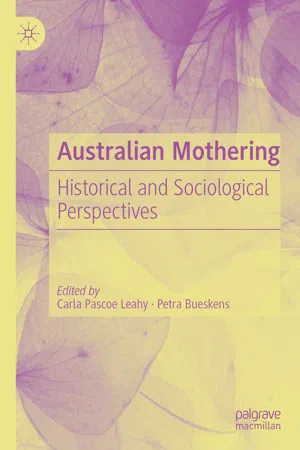Mothering impacts upon every facet of a woman’s being: her mind, her body, her relationships and her lifestyle. Motherhood influences and is influenced by all aspects of society, including medicine, law , culture, economics , technology and politics. It is therefore not surprising that maternal studies is inherently cross-disciplinary, finding expression through anthropology, cultural studies, economics, history, legal studies, literary studies, politics, psychology and sociology. Although the study of mothers has occurred for some time, maternal studies as a recognised field has only developed in the past few decades, perhaps symptomatic of the ways in which mothers are so often the taken-for-granted. Internationally, maternal studies has been encouraged and given definition through the work of the International Association for Maternal Action and Scholarship (IAMAS)1 in North America and Mapping Maternal Subjectivities, Identities and Ethics (MaMSIE) in the United Kingdom. These networks have promoted maternal studies through IAMAS’s Demeter Press and the Journal of the Motherhood Initiative, as well as MaMSIE’s Studies in the Maternal. In Australia, an antipodean arm of the North American organisation developed called the Australian Motherhood Initiative for Research and Community Involvement (AMIRCI).
While complex and significant research into mothering and motherhood has been taking place across these diverse disciplines and geographic locations, this volume represents the first attempt to synthesise and analyse Australian maternal studies, unifying these varied approaches into a coherent body of literature. It grew from a symposium convened by the editors in 2018 that brought together academic researchers with practitioners from the not-for-profit sector and government.2 Initially, that event was planned by Pascoe Leahy as an opportunity to connect leading historical research into Australian mothering. But through involvement in the interdisciplinary Maternal Scholars Reading Group convened by Bueskens in Melbourne, Pascoe Leahy and Bueskens saw the multiple advantages of bringing a range of disciplinary perspectives into dialogue with each other. From those origins, the editors determined to produce a collection that would showcase and juxtapose some of the most exciting maternal scholarship emerging in Australia, uniting several generations of Australian maternal scholars. The resulting collection brings together researchers who primarily identify as historians and sociologists but bring to their work a rich variety of disciplinary approaches, including anthropology, education, literary analysis, psychoanalysis, public policy and more. Though Australian-focused, this volume draws upon maternal scholarship occurring across the globe, and the findings made across these twenty-two chapters will find resonance and relevance in many different cultural contexts internationally. In the introduction that follows, we will sketch the historical context in which Australian mothering has taken place, propose an overarching framework for the volume and outline the chapters that follow.
The Historical Context of Australian Mothering
The context within which Australian women experience mothering has changed markedly over the past century. Yet, alongside these changes are significant continuities. Governments have consistently sought to use financial levers such as welfare payments and taxation policies to influence women’s choices in relation to fertility and employment. Women’s reproductive decisions have continued to be constrained by moral judgements and cultural discourses. In addition, the ‘optimal’ mother has been persistently defined as married, white, middle class and heterosexual.
From the moment of Federation in 1901, mothers have been prominent on the agenda of successive Australian commonwealth and state governments. At the turn of the century decision-makers were concerned at the plunging birth rate (although infant mortality had also declined). In 1891 Australian women had 7.03 children on average, falling to 5.25 by 1911.3 The New South Wales government conducted an ‘Inquiry into the Decline in the Birth Rate’ in 1903, condemning the selfish immorality of women who limited their fertility.4 In 1912, the Fisher Labor government introduced a maternity allowance available regardless of marital status or income, but not paid to ‘Asiatics, aboriginal natives of Australia, Papua or the Islands of the Pacific.’5 This measure, in conjunction with the White Australia Policy and efforts to remove children from Aboriginal parents, sent a clear message that Australian governments privileged white motherhood.6 Throughout the first half of the twentieth century, Australian men earned higher wages than women, because of the assumption—enshrined in law by the 1907 Harvester judgement—that a male breadwinner supported a wife and children.7 Although Australian women were idealised as full-time mothers, in reality, many women engaged in paid employment, particularly in manufacturing and on farms.8 If mothering was viewed as a woman’s ‘natural’ role, she was still presumed to require scientific child-rearing instruction, as infant welfare services ‘gradually became a mass movement controlled by doctors’ after 1915.9
The inter-war years (1918–1938) were characterised by an increasing medicalisation of motherhood, with the emergence of new specialities of obstetrics and paediatrics, the growth of gynaecological intervention , the increasing use of caesarean section and the extension of medical surveillance to the antenatal period.10 In 1912–1914, 29 per cent of women giving birth at the Royal Hospital for Women in Sydney attended an antenatal clinic, but by 1920–1922, this figure had risen to 50 per cent.11 Health professionals also increasingly governed the post-natal period through infant welfare clinics. By 1926 there were seventy-eight clinics in Victoria and by 1927, th...
